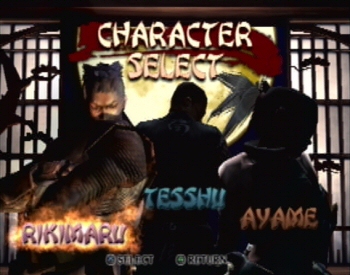
Beating the game with both Azuma Ninja, Rikimaru and Ayame, unlocks Tesshu.
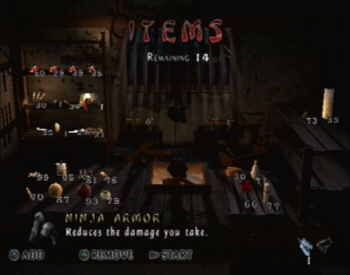
Successful completion of each stage rewards items for later use. The better you perform, the more items awarded.

Each mission has three different layouts which affects where enemies appear, theoretically expanding the game’s replay value; however, since the map, itself, doesn’t change it’s never done much to motivate me.
Review by Jay Wilson Wrath of Heaven offers one of the greatest gems in video game history: B-Side dialogue. For years I’ve played games with crappy stories and atrocious voice acting from developers trying way too hard to establish their medium as legitimate literature/cinema, and B-Side is the be-all/end-all reward for sitting through it all. This option changes the cut-scene script into an awesomely cheesy celebration of the ridiculous (which turns out to be depressingly better and far more entertaining than Rikimaru’s real storyline.) Ayame uncovers a sinister plan to ... publish a magazine. Tesshu, the physician by day/assassin by night, has to work out some relationship problems in a world that doesn’t understand his tastes. And at one point, the recurring villain Onikage tells Rikimaru he should play Tenchu 1 because “[I] was a badass in that game too!” Over the top. Silly as hell, but oh my God, I freaking love it! Tenchu, of course, is the video game series where the player takes control of a ninja in feudal Japan, and the realism level fluctuates depending on which game you happen to play. This third entry, for the most part, leans towards mystical fantasy, paving the way for some colorful characters and enemies like Kagura who uses scriptures and summons beasts to fight with her, martial artists with the ability to launch black balls of energy, the mad Dr. Kimaira who operates an oversized puppet strapped to his back, and shikigami (whatever the hell those things are supposed to be.) Tapping into fantasy also enables a few strategic doses of variety to break the monotony. Let’s be honest, for the most part the difference from one level and the next is the venue: stalking unsuspecting prey from the rooftops, stalking unsuspecting prey in the limestone caverns, or stalking unsuspecting prey in Tenrai’s island fortress. But Amagai Castle, for example, features insidious traps where the wrong turn could lead through a corridor of exploding arrows or into a pit of attacking spears; it forces you to worry more about the hazardous terrain than stalking the few clockwork mechanical sentries. In the Cemetery, your ninja face undead who require a special sword to damage; however, these swords also slowly drain the life of their wielder, taking away the luxury of waiting for just the right moment. It’s really not much, but with a game whose premise is as narrowly focused as Tenchu’s it actually does make all the difference. Once again, the story revolves around the two Azuma ninja, Rikimaru and Ayame, as they faithfully serve their master, stealth killing from the shadows and ultimately battling the evil sorcerer Tenrai multiple times in the final mission. Both ninja explore the exact same ten maps; however, the order and circumstance under which they journey there will vary. For example, Ayame visits the bamboo forest first in pursuit of missing villagers while Rikimaru goes there for his seventh mission to take down one of Tenrai’s henchmen; they start in different places, fight different bosses, and the stage is populated with different enemies (in different locations with different patrols) ... but it is the same map. While both ninja play similarly, I much prefer Ayame. I love her design: her sleeveless outfit with baggy pants, her ponytail that fans out and has a nifty feathery quality (I don’t deny that some of my character doodles have been influenced by her). I love her speed, her twin swords, her long rapid-fire combos. Her jumps feel more natural, more precise, and I can land high-risk airborne stealth kills more consistently with her. And while Ayame’s storyline isn’t anything special, it’s better than the parade of lame ass excuses trying to explain why Rikimaru didn’t die in Tenchu 1 (seriously, show him crawl out of the collapsed cave, and let that be the end of it.) 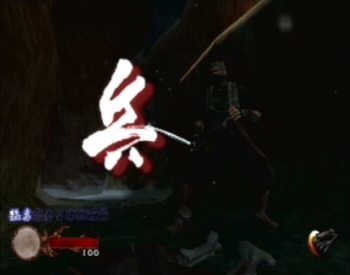
Stealth kills yeild a Kanji symbol. The more kanji symbols, the more damage you deal. Collect all nine per stage, and earn a new ability.
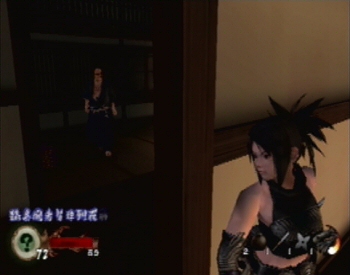
The Ki guage (lower left) indicates a guard’s proximity plus his alertness to Ayame’s presence. The higher the number, the closer he is, and the “?” means he’s oblivious to his impending demise.
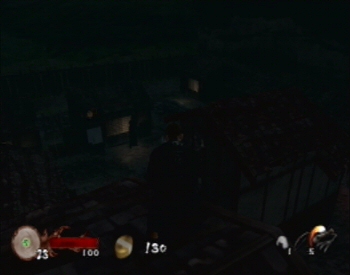
The gold easter-egg thing next to the the lifebar is unique to Tesshu. In lieu of Kanji per stealth kill, Tesshu gets those things which function as currency to buy items.
I deliberately segregated Tesshu because he feels like a built in expansion pack—a kind of side story (only six missions instead of ten) that could be dropped entirely without affecting the main plot. Instead of Tenrai, Tesshu faces his own antagonists, and he just happens to cross paths with Rikimaru and Ayame. While Tesshu has the same basic moves as the two Azuma, he does not have all of their abilities. For example, he lacks their Ninja Vision (incredibly useful) which allows Ayame and Rikimaru to see/aim much farther; he also lacks Wrath of Heaven, a stupidly risky move that doesn’t do near enough damage considering it takes your own health down to one hit point (needless to say, I never use it). Tesshu also does not get access to as many items although he can naturally mimic animal sounds without an item. Keep in mind, this isn’t a criticism; just an observation. While I didn’t particularly care for Tesshu, I am glad they included him. He provides an option for those who may feel the game got carried away with the ninja mysticism and are looking for something a little more realistic. A little more hard core. Wrath of Heaven refines the controls with a slew of minor changes that in theory complicate the inputs while in practice makes them easier. In the first game, to roll you had to hold R1 (stealth mode) and double tap the appropriate direction; now you hold R1, hold the analog stick in the direction you want to roll, and press X (jump) which feels more comfortable and natural. More importantly: it’s consistent with the new desperately needed lock-on feature (R2) that allows you to sidestep while keeping the camera focused on the nearest enemy. And, while sidestepping, pressing X will make your ninja hop in that direction for faster dodges. Better still, this allows you to confirm your hits before dedicating to a dangerous attack string. Basically, the first few hits of a combo are safe while the final hits leave your character defenseless. If the combo connects, your vulnerability doesn’t matter because they’ll be too busy picking themselves off the ground to take advantage. If they guard, however, you’re screwed. Thus, hit confirmation. Start a combo; if you land the first few blows, you can finish it for massive damage. If they guard the first couple hits, you can immediately retreat (R2+back+X) before dedicating to the risky finale. I can’t begin to tell you how much I value this which makes the inevitable boss fights feel like real showdowns where you can circle each other, dodge, and feint while waiting for the right moment to fully engage. Other changes/additions include a throw (forward+circle) which finally gives you an option to defeat blocking; however, it has limited range thus you run the risk of getting hit or thrown yourself so it’s not a universal win. The Moonsault has been simplified to R2+X, and a double jump (X twice) replaces the old long jump—both improvements over the d-pad tapping of past games. Plus as Wrath progresses Ayame and Rikimaru learn new ninja tricks such as grapple hook combos, wall kicks, parrying, and the very cool ability to cling to ceilings. Although not quite everything is a step forward. In the second game you could sheath your weapons which, other than letting you run faster, really didn’t do a damn thing. But, it was one of those little touches that added a vibe of verisimilitude so you could really immerse yourself in the game. I really miss that. A lot. Anyway, a frustration I have with video games in general is the limited interactions with the items and environment. Pretty much, you’re stuck with whatever the development team programmed for you to do which, in Tenchu especially, leads to many a situations where I feel like I should be able to do more. In Wrath of Heaven, doors automatically open all the way as you approach when you should be able to open them just a crack to get an idea of what’s on the other side. But you can’t. It’s all or nothing. Sometimes you’ll kill a guard and know a patrol will come back by. You’ll want to move the corpse out of sight, but again, you can’t1 (although, curiously enough, you could move bodies in the previous game.) You should be able to knock out non-combatants who obstruct your path (especially since one of Rikimaru’s missions is loaded with them), but no. And if you have to kill a nearby bad guy, you’re screwed because you can’t move the body out of sight thus that non-combatant will find the corpse, freak out, and put all nearby guards on alert. And there’s nothing you can do about it. Know what else would be nice? If you could shoot a blowgun or throw a shuriken between objects like you can in real life; but no, in Tenchu your projectiles collide against invisible barriers because the game thinks it struck something twelve inches away (even though you have a clear line of sight.) 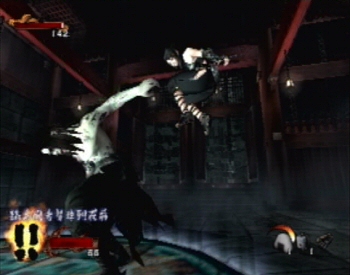
Unfortunately, you can’t Stealth Kill a boss (note the “!!” which they get automatically.) If the stage is big enough with sufficient obstacles you can hide (“?!”) and then drink a potion in safety.

Beating the game with all three characters unlocks the hidden stage “Into the Portal” where Rikimaru travels to the present to kill an evil CEO and his fat security guards.
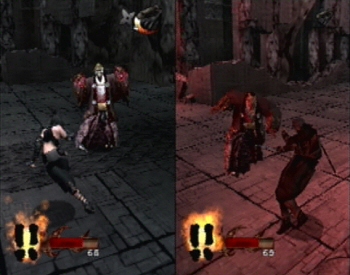
While Wrath of Heaven offers a few multiplayer options (both versus and co-op), the bulk of the game is the single player experience.
Which brings me to Tenchu’s annoying proximity issues. You see, the environment dictates both the camera and stealth mode behavior. Hold R1 with nothing nearby and your ninja will crouch. Next to a wall, he will flatten himself against it. Sometimes, especially in narrow corridors, you’ll be in a crouch trying to adjust your position to swing the camera around and see what lay beyond a corner and, instead, the game makes you flatten against the wall. A minor annoyance, but sometimes in tricky situations this can get you spotted. Likewise, the camera wants to react to your surroundings—peering over ledges and around corners (which is fine). However, at least once (usually multiple times) per level it gets confused and ends up showing an extreme close-up of the wall you’re pressed against and absolutely nothing useful. L1 gives manual control over the camera which can help in some situations, but there will come many times when the camera has auto-zoomed in so close to your ninja’s feet that no amount of L1 finessing will help. Frustrating? Sure, but not game breaking. In a screwed up way, the stupid AI actually helps mitigate these flaws. Some people complain that in Tenchu, a guard will take a shuriken to the face, freak out for ten seconds, then go back to calmly standing in place; or that even if spotted, you can use your grappling hook to climb up on a roof, hide, then wait for them to give up. Sure, ideally, I’d like the game to react more realistically—it bothers me that upon finding a dead comrade the bad guys don’t raise an alarm and go on an all out search for me. But you know what else I’d really like the game to do? Let me drag the damn body away so they don’t find it in the first place. I’m all for immersion and realism, but in a game fairness takes priority. If I’m not given the tools to do what I need to do, then damn it, I want compensation. But by far my biggest complaint has to be an encounter midway through Rikimaru’s cemetery mission. In a game designed to encourage stealth kills and discourage facing multiple opponents simultaneously, someone thought it was a good idea to force the player to fight wave after wave of undead who, by the way, are immune to pretty much all of your fancy ninja items that would be useful fighting a crowd. Only your special sword can hurt them, oh and by the way, that sword also happens to drain your health. It replenishes some life back when it kills undead, but it still drains your health. Did I mention that some undead fight melee, some shoot arrows, and others sweep an area with unblockable fire breath? God I hate that fucking encounter. This is Tenchu damnit, not Dynasty Warriors. Thank God it’s one encounter in one stage that I don’t have to ever play again. | ||||||||||||||||||||
|
1 In 2004, Wrath of Heaven was released on the XBox under the title Tenchu: Return from Darkness with two additional levels and a few new abilities including being able to drag bodies away. This review refers to the PlayStation 2 version. | ||||||||||||||||||||
